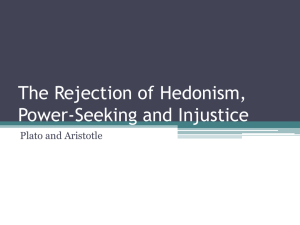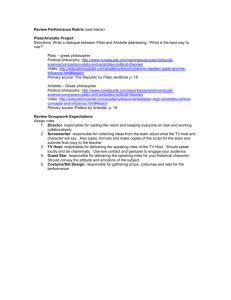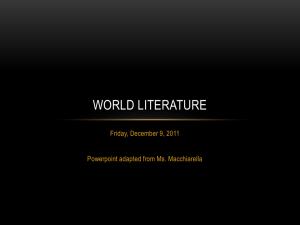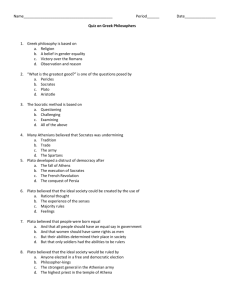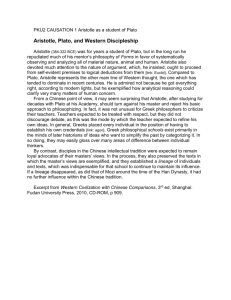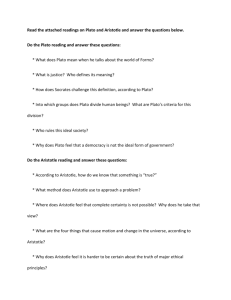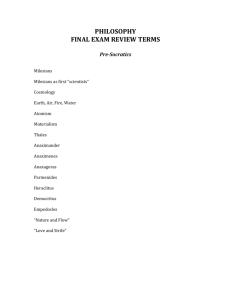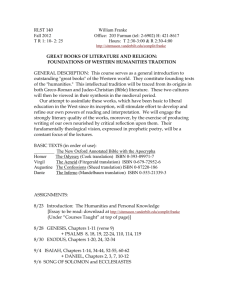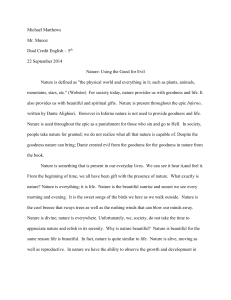Secondary readings
advertisement
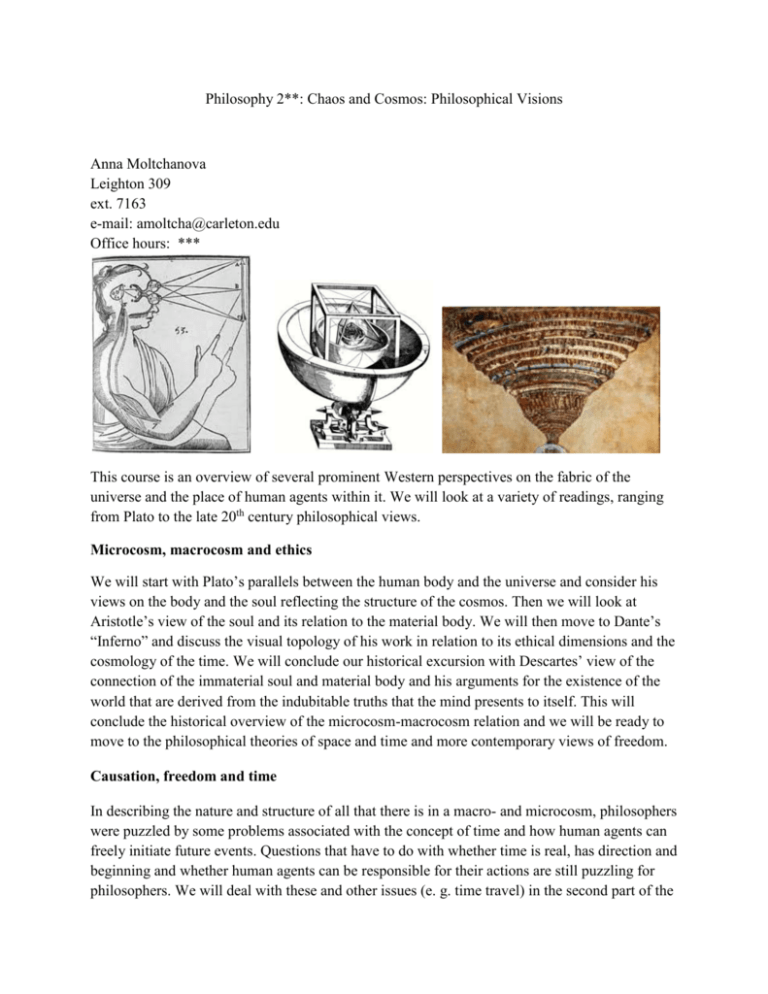
Philosophy 2**: Chaos and Cosmos: Philosophical Visions Anna Moltchanova Leighton 309 ext. 7163 e-mail: amoltcha@carleton.edu Office hours: *** This course is an overview of several prominent Western perspectives on the fabric of the universe and the place of human agents within it. We will look at a variety of readings, ranging from Plato to the late 20th century philosophical views. Microcosm, macrocosm and ethics We will start with Plato’s parallels between the human body and the universe and consider his views on the body and the soul reflecting the structure of the cosmos. Then we will look at Aristotle’s view of the soul and its relation to the material body. We will then move to Dante’s “Inferno” and discuss the visual topology of his work in relation to its ethical dimensions and the cosmology of the time. We will conclude our historical excursion with Descartes’ view of the connection of the immaterial soul and material body and his arguments for the existence of the world that are derived from the indubitable truths that the mind presents to itself. This will conclude the historical overview of the microcosm-macrocosm relation and we will be ready to move to the philosophical theories of space and time and more contemporary views of freedom. Causation, freedom and time In describing the nature and structure of all that there is in a macro- and microcosm, philosophers were puzzled by some problems associated with the concept of time and how human agents can freely initiate future events. Questions that have to do with whether time is real, has direction and beginning and whether human agents can be responsible for their actions are still puzzling for philosophers. We will deal with these and other issues (e. g. time travel) in the second part of the course. We will start with a historical overview of the problems of time and free will, going back to the Ancient Greece and considering Aristotle’s idea of the freedom of a human agent. We will next read Augustine’s account of human freedom in relation to his theory of causation and an account of the being of the universe. We will also consider Augustine’s idea of the evil. We will eventually arrive in the 20th century and read some influential works dealing with time and freedom from that period. Perspective The first two parts of the course will have given us a good background for dealing with the notion of perspective, broadly construed. It was already noted by Aristotle and Augustine that how human minds relate to reality and how humans act have certain important connections to the notions of time and causation. 20th century physics introduced a number of concepts that make measurements and statements about the universe dependent on the frame of reference. Contemporary philosophers also noted that, depending on the perspective from which we look at a human act (a first-person or a third-person perspective), we come up with different conclusions about the freedom of the agent in question. We will consider Plato’s views on painting, how philosophical shifts in the notion of the self (and Descarte’s dualism) influenced Rembrandt’s art, Mikhail Bakhtin’s view of the carnival in the Middle Ages and the Renaissance as an ontological rearrangement of the world, the Romanticism’s view of the sublime, Nietzsche’s representation of the changing philosophical paradigms, the theory of relativity, Martin Heidegger’s view of the inauthetic individual as “thethey,” Pavel Florensky’s view on the perspective in religious painting, the changes of viewpoints in representations of Dante’s Inferno through the centuries and Gilles Deleuze’s view of ontology. This course will have a large emphasis on visualization, and several assignments will require either producing images or thinking and writing about images, such as drawing pictures or maps of Plato's myths in the Phaedo or the Timeaus, inventing a visual expression of an idea about the mind and its relation to body and sketching it, in style of Descartes’ illustrations in “Treatise of Man,” providing a review of various styles in which different epochs and artists depicted Dante’s “Inferno,” visualizing a thought-experiment involved in metaphysical arguments (for example, Newton’s bucket and spheres thought-experiments, or Kant’s hand chirality thought experiment, or Lewis’s though-experiment concerning a time-traveler who intends to kill his evil grandfather). There will be a field trip to Carleton’s Special Collections. Course Requirements 1. One two-page assignment--10% with a visual component depicting an author’s viewpoint (5%)—15% in total 2. One mid-term exam--15% 3. One four-page essay 15% with a visual component (5%) representing a thoughtexperiment by a famous author (5%)—20% total 4. One visual assignment presenting your own ideas-10% 5. One team-lead class discussion—5% and a letter presenting your thinking on your persistent question--5% (10% in total) 6. Final paper—15% 7. Attendance and participation in class discussions--15% Reading Schedule We will read a variety of classic and contemporary texts while traveling back and forth in time because the course material is organized topically. I. Microcosm, macrocosm and ethics Week 1 Primary readings: Plato, The Parmenides The Phaedo Republic VI-VII Secondary readings: Peter Coles, Cosmology: A Very Short Introduction, Oxford, 2001, pp. 1-11 Images and pp. 1-46 from: Helge Kragh, Conceptions of Cosmos: From Myths to the Accelerating Universe, Oxford 2007. *M. R. Wright, Cosmology in Antiquity. Ch. 3: “Models, Myths and Metaphors,” Routledge: 1995. Weeks 2-3 Primary readings: Plato, The Timaeus Aristotle, On the Soul Secondary readings: M. R. Wright, Cosmology in Antiquity Ch. 4 Macrocosm and microcosm Gabriela Carone, Plato’s Cosmology and Its Ethical Dimensions, Cambridge, 2005. Introduction; Ch 3: Cosmic God and Human Reason in the Timaeus. Michael Frede, A Free Will: Origins of the Notion in Ancient Thought, University of California Press 2011, Chapter 2: Aristotle on Choice without a Will Albrecht Dihle, The Theory of Will in Classical Antiquity, University of California Press, 1982 Weeks 3-4 Primary readings: Dante, Inferno Descartes, Meditations Secondary readings: Antonella Braida, Luisa Calè (eds.) Dante on View: The Reception of Dante in the Visual and Performing Arts. Ashgate, 2007 Antonella Braida, “Dante’s Inferno in the 1900s: From Drama to Film” Guiliana Pieri, “Dante and Pre-Raphaelites: British and Italian Responses” Ilaria Schaffini, “From Hell to Paradise or the Other Way Round? Salvador Dali’s Divina Commedia” PLUS a variety of illustrations: Dore, Dali, Blake etc. http://www.divinecomedy.org/divine_comedy.php3?gallery?contents (especially maps of the Inferno) Plates from Descartes’ “Treatise of Man” (Harvard, 1972 or the original Latin edition in the Kierkegaard Library). II. Causation, freedom and time Week 5 Augustine, On Free Will Salmon, “Causal Connections” Chisholm, “Human Freedom and the Self” Frankfurt, “Freedom of the Will and the Concept of a Person” Week 6 Parmenides, Being Is Not Temporal Zeno, Four paradoxes as presented by Salmon Aristotle , Time Is a Measure of Change Augustine, Confessions, Book XI, sections X-XXXI Newton, “Time Is Absolute” Secondary readings: E. Edison and E. Savage-Smith, Medieval Views of the Cosmos, Bodleian library, Oxford 2004 James Trefil, Space, Time, Infinity: The Smithsonian Views the Universe, Smithonian Books, Washington, 1985 John Barrow, Cosmic Imagery: Key Images in the History of Science, 2008: “Shapeliness: The Symmetries of Life” pp. 255-257 Painting by numbers: the famous five: Platonic solids 266-270 Does God play football 272-279 (Leonardo da Vinci’s drawings) Week 7 McTaggart “The Unreality of Time” Mellor “The Unreality of Tense” Shoemaker “Time without Change” Lewis “The paradoxes of time travel” R. Le Poidevin Travels in Four dimensions: The Enigmas of Space and Time, Oxford, 2005, (pp. 52-72—on Kant) III. Perspective Week 8 Schelling, Friedrich, Bruno, or, On the Natural and the Divine Principle of Things Eva C. Keuls, Plato and Greek Painting (Columbia Studies in the Classical Tradition) (Brill Academic Pub, 1997) J. Wright, “Reading Rembrandt: The Influence of Cartesian Dualism on Dutch Art, History of European Ideas 33. 3 (Sep 2007): 275-291. P. Thielke, Who's Who from Kant to Hegel II: Art and the Absolute, Philosophy Compass 5. 5 (May 2010): 398-411 Week 9 Michael Bakhtin, Rabelais and His World Pavel Florensky, Iconostasis Albert Einstein, Relativity: The Special and the General Theory, a Popular Exposition (authorized translation by Robert W. Lawson) A trip to the special collections at Carleton to view the available representations of Dante’s Inferno through the centuries, Bayer’s Uranometria and Rosa Ursina by Christoph Scheiner. Students will also see artist books on the images of the universe. Week 10 Nietzsche, The Twighlight of the Idols Martin Heidegger, Being and Time, excerpts Gilles Deleuze, Difference and Repetition
